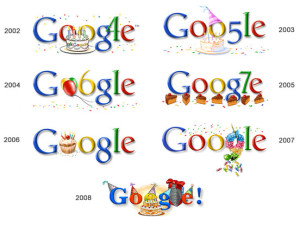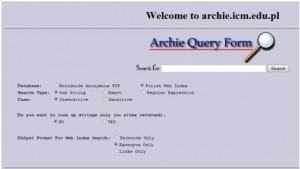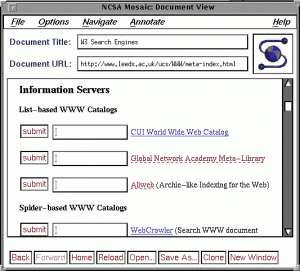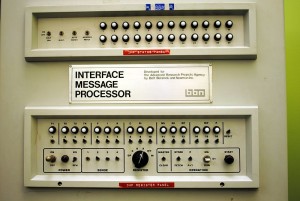The Internet
Google’s Fake Birthday
September 27th, 1998

Turn That Frown … Sideways
September 19, 1982
In a posting made to a Carnegie Mellon bulletin board, Professor Scott Fahlman proposes the first known use of emoticons (also known as smilicons or smileys). While the use of emoticons became widespread during the 80’s and 90’s, their origin remained unknown until September 10, 2002, when the original message was retrieved from backup tape.
The following is the original message:
19-Sep-82 11:44 Scott E Fahlman :-) From: Scott E Fahlman <Fahlman at Cmu-20c> I propose that the following character sequence for joke markers: :-) Read it sideways. Actually, it is probably more economical to mark things that are NOT jokes, given current trends. For this, use :-(
Side note, personally I may have been the first to use a smilicon in printed form when I put one in my high school yearbook with my senior quote under my picture. Edwardsville High School Class of 1992!
The First Internet Search Engine

The first Internet search engine, Archie, is launched. It was used to index FTP archives to make finding files easier. However, as the technology for the World Wide Web was not invented until later in the year, it was not the first web search engine.
RIAA Sues A Twelve-Year Old

The Recording Industry Association of America (RIAA) sues 261 people for sharing music on Internet peer-to-peer networks, including 12-year old Brianna LaHara. Eventually bringing suit against at least 30,000 people, the RIAA intended to reduce the amount of music being shared, but instead generated a public backlash against the established recording industry.
“Google Satellite” GeoEye-1 Launched

After 5 months of delays, the high resolution earth observation satellite, GeoEye-1, is launched from Vandenburg Air Force Base. Owned by the corporation GeoEye, Inc., GeoEye-1 is capable of taking high resolution images with detail of down to 16 inches. However, the US Government has restricted that resolution for its own use. Commercial usage is limited to resolutions with detail down to 20 inches. As the exclusive licensee of the images for online mapping purposes, Google had its logo on the Delta II rocket that was used to launch GeoEye-1.
Google Files for Incorporation

Larry Page and Sergey Brin file incorporation papers for Google in California. Filing on a Friday, the date of official incorporation would be marked as Monday, September 7th. Starting out as a privately held company, Google would hold their IPO about 6 years later on August 19, 2004.
eBay Founded

The online auction site, eBay, is launched as “AuctionWeb” by Pierre Omidyar. The first item sold, a broken laser pointer, wasn’t actually intended to sell, but rather to test the new site, itself started as a hobby. Surprised that the item sold for $14.83, Omidyar contacted the buyer to make sure he knew the laser pointer was broken, to which was replied, “I’m a collector of broken laser pointers.” From that first $14.83, Omidyar is now worth billions of dollars.
First Search Engine

The world’s first primitive web search engine is started. Known as W3Catalog or the CUI WWW Catalog, it was started by Oscar Nierstrasz at the Centre Universitaire d’Informatique (CUI) of the University of Geneva. This search site lasted for about 3 years before more modernized search engines began appearing.
I could not find an actual picture of W3Catalog, only a picture of a site linking to it. Can anybody help find me a picture of W3Catalog?
First Building Block of the Internet

The first Interface Message Processor (IMP) is delivered to Leonard Kleinrock’s research group at UCLA. The IMP was the device that would interconnect networks between research facilities on the developing ARPANET, the precursor to the Internet. As a packet-switching device, the IMP can be considered the first generation of what we now call network routers. The second IMP was delivered to the Stanford Research Institute on October 1, 1969 and the first message between the two IMPs was sent on October 29, 1969, which is now considered the first message ever sent on the Internet.
The Birth of Linux

Linus Torvalds posts a message to the Internet newsgroup comp.os.minix with the subject line “What would you like to see most in minix?” This is the first announcement that he is working on an operating system that will one day become Linux.
